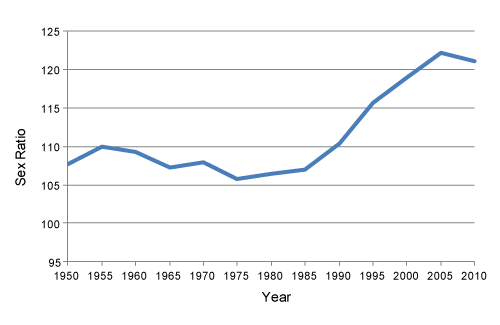Sex ratios (cont.)
Exercise

Above is a graph of the sex ratio at ages 0-4 in China, for the period 1960-2010.
![]() Examine the graph and then answer the following questions
Examine the graph and then answer the following questions
1. Since 1990, the sex ratio at ages 0-4 in China has been:
- Within the normal range
- Above the normal range
- Below the normal range
2. In general, a sex ratio at the youngest ages outside the range of 104-107 may result from (you can select more than one answer):
- Sex-selective infanticide
- Genetic factors
- Poor data quality
- Chance
- Sex-selective abortion
- Inherent (biological) mortality differentials
- Mortality differentials due to differences in care
The correct answers are a) sex-selective infanticide, c) poor data quality, e) sex-selective abortion and g) mortality differentials due to differences in care.
Because of the consistency in the values of the sex ratio at birth across the majority of countries in the world, variations in the sex ratio at birth can be taken as indicative of poor data quality, particularly under-enumeration of the births of a particular sex.
Answers a), e) and g) are all linked to preferences for offspring of a particular gender (usually male). Family composition preferences (i.e. desired numbers of sons and daughters) may be realised through any of these methods, and this will lead to a skewed sex ratio. In most areas female infanticide and deliberate or unconscious withholding of food and medical treatment for female infants has been replaced by sex-selective abortion following the spread of technology which allows early sex determination of a foetus.
3. What do you think the consequences of an abnormally high sex ratio at birth may be?